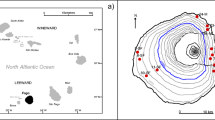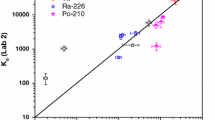Abstract
Non-natural uranium (U) isotopic compositions have been reported in tree bark from southwest Ohio. Atmospheric releases of U from the nearby former Fernald Feed Materials Processing Center are thought to be the source (GSA Abstr progr 45:78612, 2013). This study employed scanning electron microscopy equipped with backscatter detection and energy dispersive absorption X-ray spectrometry to identify and chemically characterize a 14 µm U-rich particle found in tree bark growing within 1 km of the FFMPC. Simple atmospheric dispersion calculations demonstrate that a ~5 µm diameter U-rich particle can be transported up to 38 km by wind.


Similar content being viewed by others
References
Conte E, Widom E (2013) Chemical and lead isotopic constraints on sources of pollution in tree bark in southwest Ohio. GSA Abstr Progr 45(7):78612
Groberty B, Giere R, Dietze V, Stille P (2010) Airborne particles in the urban environment. Elements 6:229–234
Giere R, Querol X (2010) Solid particulate matter in the atmosphere. Elements 6:215–222
Lloyd NS, Mosselmans JFW, Parrish RR, Chenery SRN, Hainsworth SV, Kemp SJ (2009) The morphologies and compositions of depleted uranium particles from an environmental case-study. Mineral Mag 73:495–510
Tortorello R, Widom E, Renwick WH (2013) Use of uranium isotopes as a temporal and spatial tracer of nuclear contamination in the environment. J Environ Radioact 124:287–300
Quinto F, Steier P, Wallner A, Srncik M, Bichler M, Kutschera W, Terrasi F, Petraglia A, Sabbarese C (2009) The first use of 236U in the general environment and near a shutdown nuclear power plant. Appl Radiat Isot 67:1775–1780
Rosamilia S, Gaudino S, Sansone U, Belli M, Jeran Z, Ruisi S, Zucconi L (2004) Uranium isotopes, metals and other elements in lichens and tree barks collected in Bosnia-Herzegovina. J Atmos Chem 49:447–460
Sansone U, Denesi PR, Barbizzi S, Belli M, Campbell M, Gaudino S, Guogang J, Ocone R, Pati A, Rosamilia S, Stellato L (2001) Radioecological survey at selected sites hit by depleted uranium ammunitions during the 1999 Kosovo conflict. Sci Tot Environ 281:23–35
DOE (2001) Characteristic of uranium and its compounds http://web.ead.anl.gov/uranium/pdf/UraniumCharacteristicsFS.PDF. Accessed 2 Apr 2015
Ma R, Bellis D, McLeod CW (2000) Isotopic analysis of uranium in tree bark by ICP mass spectrometry: a strategy for assessment of airborne contamination. Anal Chem 72:4878–4881
Makhijani A (2000) Radioactivity in the Fernald Neighborhood. SDA 5
Widom E, Kuentz D (2010) Minor isotopes of uranium as sensitive tracers of environmental contamination. GSA Abstr Progr 42:451
McHugh KC, Widom E, Spitz HB and Glover SE (2015) Analysis of sugar maple tree cores for monitoring environmental uranium contamination. This issue
Giere R, Kaltenmeier R, Pourcelot L (2012) Uranium oxides and other airborne particles deposited on cypress leaves close to a nuclear facility. J Environ Monit 14:1264–1274
Wolterbeek HT, Bode P (1995) Strategies in samples and sample handling in the context of large scale plant biomonitoring surveys of trace element air pollution. Sci Tot Environ 176:33–43
Killough GG, Rope SK, Shleien B, Voilleque PG (1999) Nonlinear estimation of weathering rate parameters for uranium in surface soil near a nuclear facility. J Environ Radioact 45:95–118
Lo D, Fleischer RL, Albert EA, Aranson JG (2006) Location, identification, and size distribution of depleted uranium grains in reservoir sediments. J Environ Radioact 89:240–248
Danesi PR, Markowicz A, Chinea-Cano E, Burkat W, Salbu B, Donohue D, Ruedenauer F, Hedberg M, Vogt S, Zahradnik P, Ciurapinski A (2003) Depleted uranium particles in selected Kosovo samples. J Eviron Radioact 64:143–154
Acknowledgments
Funding for this project was provided by a Miami University Committee on Faculty Research (CFR) Grant to Dr. Elisabeth Widom. We would like to acknowledge the Miami University College of Arts & Sciences and the Center for Advanced Microscopy & Imaging for support and access to the electron microscopy facilities, and we give special thanks to Joshua Silverstein and Matt Duley for assistance with the SEM work.
Author information
Authors and Affiliations
Corresponding author
Electronic supplementary material
Below is the link to the electronic supplementary material.
Rights and permissions
About this article
Cite this article
Conte, E.R., Widom, E. & Kuentz, D. Characterization and transport modeling of uranium particle from Fernald area tree bark. J Radioanal Nucl Chem 307, 1675–1679 (2016). https://doi.org/10.1007/s10967-015-4388-7
Received:
Published:
Issue Date:
DOI: https://doi.org/10.1007/s10967-015-4388-7




